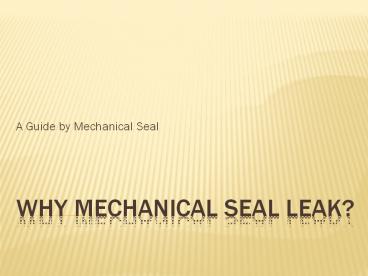Why Mechanical Seal Leak? - PowerPoint PPT Presentation
Title:
Why Mechanical Seal Leak?
Description:
How to fix mechanical seal leakage? Read more: Here are the Causes of Mechanical Seal leakage. The design of mechanical seals is such that a thin film of liquid always exists between the seal faces. Further details please call us at +91 7069871592 or visit our website: Bellow you can find us at social media: Facebook: Twitter: Linkedin : – PowerPoint PPT presentation
Number of Views:39
Title: Why Mechanical Seal Leak?
1
Why Mechanical Seal Leak?
- A Guide by Mechanical Seal
2
How to Fix Mechanical Seal Leakage
3
CAUSES OF MECHANICAL SEAL LEAKAGE
- You wont like the mechanical seal to leak ever,
but it is not possible. All mechanical seals leak
after some time due to wear and tear. - You can prolong the occurrence of leakage by
taking diligent care of the seals, but it is
impossible to avoid itcompletely. - As we know the mechanical seal has two
components a stationary member called seat and
a rotating member called head. - The head is statically sealed to the pump shaft,
and it rotates with it. The seat is statically
sealed to a stationary cover. - When the stationary and rotating parts are in
near contact, the primary sealing takes place.
4
HARD CONTACT CAN CAUSE LEAKAGE
- Hard contact of the seal faces means the rotation
without lubrication builds up friction. That
causes damage to the seal face. - It is one cause of leakage. Hence, utmost care is
required not to run the seal faces dry. - Thankfully, the design of mechanical seals is
such that a thin film of liquid always exists
between the seal faces. - When the seal operates flawlessly, the thin film
leaks to the side where the pressure is low. It
means outside the pump.
5
- In a single type mechanical seal pump, the
overflow liquid is handled by the pump. In double
or tandem type pumps, a barrier fluid is placed
between the seals. - The barrier fluid is supplied in such a way that
one of the seals is exposed to the barrier fluid
only. The inner seal is exposed to the liquid
that is being pumped. - In some pumps, pressurized gas is used to prevent
the leaking.
6
LEAKAGE IN VOLATILE LIQUID PUMPS
- While pumping volatile liquids, the fluid
friction increases when it traverses through the
seal faces. Thus, the fluid vaporizes and doesnt
show a visible leakage. - However, if the liquid is not volatile, we can
see an accumulation of leakage outside the pump.
7
A few parameters that determine the amount of
leakage in the seal are
- Type of liquid to be sealed
- Sealing pressure
- Speed of rotation
- Size of mechanical seals
- Face loading
- Material and finishing of the seal
- Temperature
- Pressure
- The viscosity of the liquid
8
- Some seals are designed for high face loads. Here
the leakage is minimal, but the seal doesnt last
long. In light face load, the seals last long,
but there is a high probability of leakage. - Hence, it is critically important to choose the
right type of seal in the pump.
9
- Leak-Pack is ISO 90012008 certified company and
one of the best mechanical seals suppliers,
manufacturers and exporters in India, providing
solutions to all types of leakages by
manufacturing Mechanical Seals and Sealing
Components as per customers drawings, samples or
requirements. To know more about Mechanical Seal
call on 91-(2739) 271592 or email at
info_at_leakpack.com. - Read More Articles
- What is a Mechanical Seal in a Pump?
- How many types of mechanical seals?
10
Contact US
Website
https//www.mechanicalsealsindia.in/
Phone No7069871592
Email ID info_at_leakpack.com
Address 2852/15/1, B/H Hotel Patel,Chhapi to
Pirojpura Road,Chhapi, Ta. Vadgam, Dist.
Banaskantha,North Gujarat 385210India































